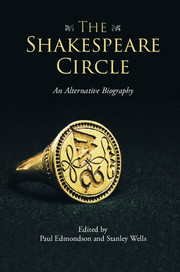Book contents
- Frontmatter
- Contents
- List of illustrations
- List of contributors
- Preface and acknowledgements
- General introduction
- Part I Family
- Part II Friends and Neighbours
- Part III Colleagues and Patrons
- 18 His fellow dramatists and early collaborators
- 19 His theatre friends: the Burbages
- 20 His fellow actors Will Kemp, Robert Armin and other members of the Lord Chamberlain's Men and the King's Men
- 21 His literary patrons
- 22 His collaborator George Wilkins
- 23 His collaborator Thomas Middleton
- 24 His collaborator John Fletcher
- 25 His editors John Heminges and Henry Condell
- Closing remarks
- Afterword
- Index
- References
25 - His editors John Heminges and Henry Condell
from Part III - Colleagues and Patrons
Published online by Cambridge University Press: 05 November 2015
- Frontmatter
- Contents
- List of illustrations
- List of contributors
- Preface and acknowledgements
- General introduction
- Part I Family
- Part II Friends and Neighbours
- Part III Colleagues and Patrons
- 18 His fellow dramatists and early collaborators
- 19 His theatre friends: the Burbages
- 20 His fellow actors Will Kemp, Robert Armin and other members of the Lord Chamberlain's Men and the King's Men
- 21 His literary patrons
- 22 His collaborator George Wilkins
- 23 His collaborator Thomas Middleton
- 24 His collaborator John Fletcher
- 25 His editors John Heminges and Henry Condell
- Closing remarks
- Afterword
- Index
- References
Summary
Their names usually appear together as Shakespeare's friends, fellow actors and ‘editors’ of the 1623 Folio. But how might Shakespeare have perceived them? John Heminges (1566–1630) and Henry Condell (1576–1627) were men he trusted and liked. Along with Richard Burbage, they were added to the latest draft of his will and bequeathed 26s 8d each (one mark) to buy mourning rings. Shakespeare refers to them there as ‘my fellows’; all three men had sons named William. Perhaps Shakespeare's bequests formed an informal contract for them to oversee the 1623 edition of his collected plays, though Burbage died in 1619 (Wells 2002, p. 99).
Like Shakespeare, Heminges and Condell acted, invested in businesses, and acquired real estate. They lived in the parish of St Mary's, Aldermanbury, less than ten minutes’ walk away from Silver Street where, in 1604 and probably for longer, Shakespeare was lodging with his friends the Mountjoys. Both men combined civic duty with religious conviction in their local church. Condell is mentioned as a sidesman in 1606 (Lee 1887, p. 469), and in 1617 Heminges signed the register twice as second warden and three times as the first, and Condell signed it twice as second warden (Edmond 2004, 12, p. 919). They helped to organise services, noted absentees, distributed local poor relief, oversaw the upkeep of the building and maintained the goodwill of its surrounding communities. Condell met with some prejudice when he took up the office ‘only in regard of his profession, he being a player’. But personal testimonies noted that he had been ‘a parishioner of the parish of St Mary Aldermanbury by the space of 21 years and more, hath in that parish borne all offices up to the place of churchwarden and always held in good repute and estimation among his neighbours’ (Archer 2009, p. 400). In 1619, Heminges and Condell were listed as ‘feoffees’ (trustees) of the parish land (Bentley 1941, p. 411). Perhaps they were emulating Shakespeare in their service to the Church. Shakespeare had purchased a share of the Stratford-upon-Avon tithes in 1605, a shrewd financial investment, but one through which he took on financial responsibility for the church's upkeep. Churchwardenship there was not viable for Shakespeare, who had to spend long stretches of time in London, but he was, like his friends, demonstrating support for the established state Church of England.
- Type
- Chapter
- Information
- The Shakespeare CircleAn Alternative Biography, pp. 315 - 328Publisher: Cambridge University PressPrint publication year: 2015

